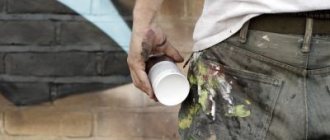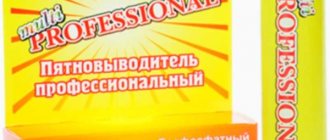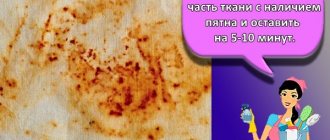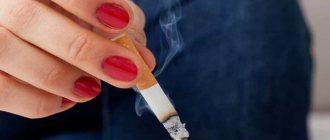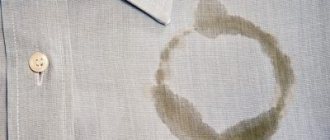Resin is a plant or synthetic substance that is usually hard, but becomes softer when heated. If you choose a New Year's beauty, be careful with the trees: the resin from them is difficult to wash off.
It’s easy to get dirty in the forest, park, or when throwing away a Christmas tree. But it’s not so easy to wash, the resin has a complex structure. However, you can remove it: you can clean clothes in several ways.
Preliminary resin removal work
The more resin that is removed from the jacket in a gentle manner, the better the final result.
Mechanical method
You need to carefully remove the resin with a knife, but if it does not give in, then put the item in a plastic bag and in the freezer for an hour. At low temperatures it will harden, crack, and can be easily cleaned with a brush. In this case, not all the resin can come off - a stain remains from it.
Preparing the jacket
Before further rubbing off the remaining spruce resin, the jacket should be prepared:
| 1 | Clean - other contamination can lead to drips. It is better to do this with a dry brush. |
| 2 | If there is a lining, it must be torn off at the site of contamination. |
| 3 | Place something hard under the stain - a piece of wood wrapped in cloth. |
| 4 | Moisten the cloth near the stain with water, take talc or starch, sprinkle it on the water so that the stain does not spread. |
Proper preparation
To clean clothes you need to prepare in advance:
- spatulas (wooden or metal);
- iron (required for heat treatment) or freezer;
- solvents (gasoline-containing products, acetone, alcohol-containing substances, etc.);
- napkins or disposable paper towels;
- cotton pads;
- other laundry detergents.
First you need to try to remove the resin from clothing mechanically, scraping it off with a spatula. You need to clean it off very carefully so that it does not eat into the fabric.
The method is not suitable for delicate fabrics (silk, fine knitwear, etc.).
You also need to prepare the material itself:
- clean the surface from dust with a clothes brush to avoid dirty marks;
- tear off the lining from the outer clothing so that only the soiled fabric is affected;
- stretch the soiled part of the clothing onto a wooden block or plastic wrapped in paper towels;
- Wet a clean cloth around the stain with water and sprinkle it with talc to prevent the resin from spreading further.
Thermal method
This method is good for fresh stains. Suitable for delicate fabrics, even those that cannot be frozen.
- Place rags or paper napkins on the stain and under it.
- The iron heats up and irons the stain through the paper - it melts and sticks to it.
- Contaminated rags or napkins are changed.
- This action is carried out until the stain is completely cleaned.
- Then the item is soaked for 20 minutes, the stain is first rubbed with household
- soap and washable.
- The stain was completely washed off.
For jackets made of thick fabric or leather, you need to use a hairdryer. When exposed to hot air, the resin melts and can be removed with a napkin.
Methods for removing resin from clothes
Not only a child, but also an adult can get dirty with coniferous tree resin. You should not immediately throw away your clothes; you should try to wash off pine resin at home, using different options.
Mechanical cleaning:
- First you should wait until the composition dries a little. The viscous mass of coniferous wood, as a rule, is spread over a large area of clothing during cleaning. The crust should be peeled off with a knife. You need to act carefully so as not to damage the fibers of the fabric.
- After this, put the item in a bag, close it tightly and put it in the freezer for 3-4 hours. During this time, small particles will harden and will be easier to wash off.
- Then rub the damaged area with a brush to remove resinous pine wood residue from the clothing.
Important!
If delicate or thin fabric is stained, you will have to skip freezing, since this procedure disrupts the structure of the fibers. There are other important points to consider:
- The liquid mass on clothes spreads quickly and can stain a large area. To prevent this from happening, create a wet area in the area around the contaminated area and sprinkle it with talcum powder.
- They begin to wash the stain from the viscous mass of pine wood from the inside of the clothes. The front side is lined with a white cloth or paper napkin so as not to stain the trousers or jacket.
- A small stain can be removed using a pipette and a cotton swab.
- Washing starts from the edge and moves to the center.
Alcohol, gasoline, nail polish remover, turpentine, acetone
Spruce resin can be washed well with alcohol, if, of course, mechanical treatment has been carried out before this. Dip a cotton swab in alcohol and wet the stain. The item lies in this form for about 20 minutes, then the stain is easily cleaned. The item definitely needs to be washed. Alcohol is the safest agent for fabric; it is well suited for removing resin from suede, fur jackets, and items made of silk and velvet.
In the same way, use turpentine, acetone, nail polish remover and gasoline (only special, purified).
You can simply use turpentine to wash off the tree resin from a woolen product.
But for delicate fabrics, it is better to take a mixture of laundry soap and gasoline or kerosene - in equal parts. Apply it to the stain for an hour, then wash it.
Features of removing resin from different types of fabrics
If jeans are made from durable fabrics, then for jackets they use leather, artificial leather, suede, velor, and synthetics. Therefore, before washing the viscous mass of pine from clothes, you need to decide on the composition of the fabric. Only in this case can you choose the necessary remedy.
Warning! Before using bleaches, solvents, or chemicals to remove tar from jeans or a jacket, you need to check that they will not remove the paint. You can check the product from the inside out.
Helpful Tips:
- Delicate fabrics can be washed from the viscous mass of pine wood using vegetable oil and dishwashing detergent.
- It is better to wash jackets made of fur, leather, leatherette with alcohol.
- Turpentine, soap, and alcohol will do an excellent job of removing resin on woolen products.
- Jackets covered with velvet, velor, silk and other delicate fabrics are washed using ether, alcohol, and starch.
- Synthetic fabrics cannot be washed off wood resin using gasoline.
Chemicals
When purchasing solvents and bleaches, you need to make sure that they are suitable for clothing and that there are instructions for use.
Well-proven products: Vanish OXI Action bleach-stain remover, Udalix Oxi Ultra stain remover in powder form, Dr. stain remover. Beckmann (marked - against resin). Manufacturers guarantee color preservation and odorlessness.
And for synthetics, a suitable product is white spirit.
How can I remove it using folk remedies?
The ingrained resin can be removed with various homemade “reagents” that are always on hand. To achieve a positive result, it is worth remembering an important rule: the fresher the stain, the easier it is to deal with.
How to remove a stain with Coca-Cola?
The drink contains orthophosphoric acid. It is she who is entrusted with the task of dissolving resinous compounds. Instead of Coca-Cola, you can use any soda with a similar composition:
- Pepsi,
- Sprite,
- Fanta.
The cleansing procedure consists of several steps:
- Coca-Cola is poured into a wide container;
- dip the area with the stain into the liquid;
- stand for several hours;
- Clean off dirt with a soft brush.
For white items, it is recommended to use a clear drink. The product should be soaked in liquid for an hour. Soda contains acids that dissolve resin components. The result will be noticeable immediately. After the manipulations, you need to rinse the clothes in cool water several times or wash them in a machine.
Alcohol
You can remove resin from clothes with regular alcohol or vodka. The method is good and safe for any thing, but not always effective.
Sometimes it is necessary to carry out several procedures to remove resin from clothing.
How to remove a stain:
- Lay the item out on a flat surface. Place a clean and preferably dense piece of unnecessary material under the contamination.
- Soak part of the bandage with alcohol or vodka and wipe the stained area. Don't be afraid, rub harder. Apply the moistened bandage to the contaminated area for half an hour. Then wipe off anything that has dissolved.
- Rinse off the residue under running water, then wash the item using powder and fabric softener.
Alcohol, unlike vodka, can not only remove resin from clothes, but also corrode the dye.
If the pine resin stain is still fresh, then the most effective way to get rid of the stain is to use alcohol and a cotton pad.
After which the “saved” item is sent to the washing machine.
This method will be effective even for light-colored items, since they are not afraid of the effects of the alcohol base.
You can remove the stain using pure ethyl alcohol, tincture or colorless alcohol. The method is effective, but takes a lot of time. Acetone is suitable for cleaning light, plain items without a pattern. There is a risk that the clothes will fade.
Starch
This home remedy helps restore the appearance of fluffy fabrics. All manipulations are carried out in a certain sequence:
- A paste is prepared from starch and water.
- Apply the paste generously to the stain.
- They stand for several hours.
- Wash off the starch and dry the area.
- Remove remaining resin with a cloth soaked in gasoline.
With milk
Milk is used to remove resin stains. The product must be soaked in milk for 2-3 hours. Then rinse in cold water and hang the clothes out to dry in fresh air.
Gasoline or turpentine will help remove tar from jackets, jeans and shoes.
Petroleum products contain film-forming agents that can clean fabric. Apply gasoline mixed with liquid soap to the stained area until the resin is completely separated from the fibers of the material. After thoroughly washing your clothes with powder, you need to ventilate the items, leaving them in the air for 3-4 hours. To eliminate the odors of gasoline, kerosene and solvents, you need to use a special scented mouthwash or conditioner.
Dish detergent
has good foaming properties and contains surfactants that can clean the surface of the material. This method will help remove resin stains from fur coats and carpets. Dirt must be removed with a mixture of vegetable oils combined with detergent. It is necessary to rub the stained area with a brush to completely clean the surface.
Heating with an iron or hair dryer
This method is most effective when removing fresh tar stains. Use an iron or hair dryer to heat the fabric.
The procedure algorithm includes several sequential steps:
- the item is placed on a hard surface;
- the stain is covered from below and from above with woven paper cloth;
- heat the area of the product until the resin saturates the cotton pad;
- replace dirty liners with new ones;
- repeat the heat treatment until the stain completely disappears from the product.
Instead of a cotton pad, you can use thick porous paper or paper towels.
Fabric material
To choose a cleaning product, you need to know what material the damaged item is made of. Otherwise, a hole may appear in place of the stain, paint may peel off, or something else unpleasant.
The label of each item indicates the composition of the fabric and how to care for it. If the information has been erased or there is no longer a label on the item, then you should adhere to the following rules:
Wool and silk should not be exposed to saturated alkaline solutions. In order to clean the surface of these materials from resin, use ammonia or a mixture of one teaspoon of starch and 5-6 drops of turpentine.
- Resin is removed from cotton using acetone or turpentine. After the resin has dissolved, the treated area of clothing is blotted with alcohol and washed off with water.
- Bologna fabric or silk acetate is cleaned with gasoline. Such materials cannot be cleaned with acetone or acetic acid.
- Nylon and nylon cannot be cleaned with gasoline, alkaline solutions, or benzene. Resin stains from these materials are removed with laundry soap and warm water.
- Leather items do not tolerate solvent exposure. It is better to clean them with vegetable oil.
- You can remove resin from jeans using turpentine and ammonia in a 1:1 ratio. Potato starch is added to the resulting mixture to obtain a thick paste, which should be used to smear the area of contamination. After the product has completely dried, it is removed from the fabric and the item is washed.
- Membrane outerwear is cleaned of resin using laundry soap and turpentine. To do this, dissolve one part of turpentine in two parts of water and add grated oil to the mixture. Use the resulting product to wash the contaminated area.
Getting ready
Do not panic, but immediately study the information on the label of your jacket or pants. Determine the composition of the fabric. Next, find out the nature of the tar stain.
Let's figure out how to prepare to successfully remove pine and epoxy resin from clothing.
Nuance 1 - Type of wood resin and epoxy resin
Resins are of natural and synthetic origin. Each stain requires special treatment, but in general, removing these stains has much in common.
For information, synthetic resins wash worse than natural ones.
Wood resin is viscous droplets that quickly harden when exposed to air. Coniferous resinous trees secrete amber drops of oleoresin as tissue protection. Spruce, fir, cedar and pine resins are collected in special suits. The resin released by the tree is insoluble in water, but can be easily removed by carbonated drinks and various alcohols.
Epoxy resins are a finishing material; glue is prepared on their basis; epoxy is also used in creativity. May resemble tree resin, honey, tar. It dissolves in alcohols, melts and is destroyed by freezing.
Point 2 - Clothing material
The method of washing it depends on the type of material:
- silk, chiffon and other thin delicate fabrics are cleaned only thermally, no solvents or mechanical treatment, freezing also harms them;
- Jeans are very convenient to place in the freezer; frozen resin comes off easily from this twill material;
- natural wool can be cleaned well with turpentine;
- Only vegetable oil is used for skin;
- suede, velvet and other fleecy materials are cleaned with medical alcohol, vodka (by the way, fluffy fabrics retain the smell of solvents for a long time, so avoid gasoline, white spirit, etc.);
- synthetic strong fabrics are subject to heat treatment and do not tolerate solvents;
- Organic solvents work effectively on cotton products, such as calico.
Advice: Remove tar stains completely, otherwise machine washing will absorb them even deeper into the fibers of the clothing.
Nuance 3 - Fresh and old stains
The fresher the resin stain, the easier it is to remove. Old contaminants eat deeply into the structure of the material; several different procedures may be required. In particularly advanced cases, you will have to go to dry cleaning.
Point 4 - Prepare items for stain removal
If the material allows, first try to remove the resin layer mechanically. Use a knife blade or a thin spoon to scoop it out. Just don’t tear the fabric: don’t use force, don’t scrape the fibers with a sharp blade, and don’t stretch the clothing.
Tip Before removing the resin, wet the cloth around the stain. Moisture will prevent dirt from spreading.
Removing stains and odors after cleaning
After you get rid of the resin, any item needs to be sent to the wash. Use laundry soap or liquid powders, if the fabric allows, then with bleaching properties. Adding a scent conditioner will help.
A simple trick that will protect the cleaned item from streaks: pour regular milk into a bowl and soak the fabric for 2-3 hours. After soaking, the fabric should be rinsed well and dried in a suitable manner.
Don't be careless about tar stains. The faster you take on the problem, the higher the likelihood of success. A rational sequence of actions will save expensive clothes, shoes and camping equipment.



